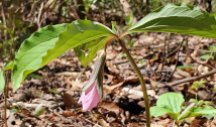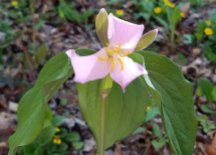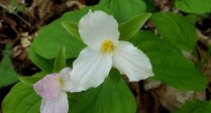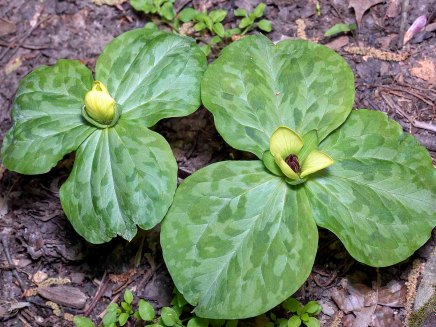It’s hard to beat seeing a large patch of blooming Trillium in the spring. Whether it’s cruising the Roaring Fork Motor Trail in the Great Smoky Mountains National Park, driving the Nantahala Gorge, or creeping down Pearson’s Falls Road, everyone slows down to look at the masses of Trillium grandiflorum.
The species name, Trillium, is derived from tri for “three”. The foliage, sepals, and petals of adult trilliums occur in threes or multiples of threes, although mutations may occur causing some plants to bear more than three leaves. Young trillium plants generally spend several years in a one-leaf stage.
Trillium species fall into one of 2 general groups based on their structure. Pedicellate trilliums bear their flowers on a short stem (pedicel) with spreading petals and sepals and exposed reproductive structures. In contrast, the flowers of sessile trilliums have no pedicel and the petals are erect, often touching each other and covering the reproductive structures.
 Structurally, trillium differ from most other plants. The trillium “stem” is a hidden underground horizontal rhizome. The rhizome is covered with dry, scale-like modified leaves called cataphylls. The stalk that arises from the rhizome is a leafless scape or peduncle bearing a flower. Bracts are leaf-like structures located above the leaves and below the flowers. Thus, by definition, the leaf-like photosynthetic structures on trillium are bracts, but in the descriptions below they are listed as “leaves” since most observers will call them that.
Structurally, trillium differ from most other plants. The trillium “stem” is a hidden underground horizontal rhizome. The rhizome is covered with dry, scale-like modified leaves called cataphylls. The stalk that arises from the rhizome is a leafless scape or peduncle bearing a flower. Bracts are leaf-like structures located above the leaves and below the flowers. Thus, by definition, the leaf-like photosynthetic structures on trillium are bracts, but in the descriptions below they are listed as “leaves” since most observers will call them that.
 The reproductive portion of trilliums consist of six stamens surrounding an ovary. Each stamen consists of a filament surrounded by a two-chambered anther (the pollen-bearing portion of the stamen). Three stigmas (receptive to pollen) extend from the ovary. The color of the filament, anthers, and ovaries can be useful for identifying some trillium species.
The reproductive portion of trilliums consist of six stamens surrounding an ovary. Each stamen consists of a filament surrounded by a two-chambered anther (the pollen-bearing portion of the stamen). Three stigmas (receptive to pollen) extend from the ovary. The color of the filament, anthers, and ovaries can be useful for identifying some trillium species.
The most common Trillium species found in the Southern Appalachians are described below.
Pedicellate Trillium Species
Catesby’s Trillium (Trillium catesbaei)
- Stem: Slender
- Leaves: Light green. Unmottled
- Flowers: White or pink petals often curved back on themselves. Borne on a recurved pedicel so they hang below the leaves
- Stamens: Bright yellow
- Ovary: White, six-angled
- Notes: Generally found at lower elevations
- Derivation of Scientific Name: Named after the English naturalist, Mark Catesby
Maroon-colored Wake Robin & White-colored Wake Robin (Trillium erectum)
- Stem: Tall and rigid. Plants often grow in clumps
- Leaves: Bright green. Unmottled
- Flowers: Narrow white or red, occasionally cream petals. Borne on an erect pedicel and facing forward. Sepals can be clearly seen between the petals
- Stamens: Cream colored or yellowish
- Ovary: Dark maroon, six-angled
- Fruit: Black, six-angled
- Notes: Common. Red form is generally found at higher elevations than the white form.
- Fruit: Derivation of Scientific Name: From Latin meaning “erect” or “upright”
Large-flowered Trillium (Trillium grandiflorum)
- Leaves: Dark green. Unmottled
- Flowers: Large white petals, with a funnel- or tube-like base. Borne on an erect pedicel and facing forward. Sepals lie behind the petals. Petals fade to pinkish-red with age.
- Stamens: Bright yellow
- Ovary: Pale green, six-angled
- Fruit: Light colored, six-angled
- Notes: Common in the mountains. An early bloomer
- Derivation of Scientific Name: From Latin meaning “large-flowered”
Southern Nodding Trillium (Trillium rugelii)
- Leaves: Bright green. Broader than long. Unmottled
- Flowers: Normally has large white petals, although plants that hybridize with Trillium vaseyi may have petals with colors that vary from pink to maroon. Petals usually curved back on themselves. Flowers are borne on a recurved pedicel so they hang below the leaves and the flower faces downwards
- Stamens: Cream-colored filaments. The anthers (pollen bearing portion) become dark purple.
- Ovary: Dark maroon, six-angled
- Notes: Uncommon
- Derivation of Scientific Name: Named after Ferdinand Rugel, a German-born plant collector who is considered one of Tennessee’s botanical pioneers
Sweet White Trillium (Trillium simile)
- Leaves: Large, medium green. Unmottled
- Flowers: Large white petals, often with obvious venation. Petals overlap at the base, distinguishing them from T. erectum. Borne on an erect pedicel and facing forward.
- Stamens: Yellow; much longer than the ovary
- Ovary: Dark purple-black. Compare to light-colored ovary of T. grandiflorum
- Notes: Rare. Found at lower elevations than T. erectum. Also known as “Confusing Trillium”!
- Derivation of Scientific Name: From Latin meaning “like” or “similar”
Painted Trillium (Trillium undulatum)
- Stem: Usually short and dark colored
- Leaves: Dark green with a distinct petiole. Occasionally plants with 4 or 5 leaves may be found!
- Flowers: White, usually with a red “V” at the base of each petal
- Stamens: White; shorter than the stigma
- Ovary: White
- Fruit: Bright red oval-shaped berry
- Notes: Common in the mountains; less common elsewhere
- Derivation of Scientific Name: From Latin referring to the wavy edges of the petals
Vasey’s Trillium (Trillium vaseyi)
- Leaves: Very large. Usually wider than long
- Flowers: Large. Dark maroon in color. Petals overlap at the base and are usually curved back on themselves. Flowers are borne on a recurved pedicel so they hang below the leaves and the flower faces downwards
- Stamens: Long. Dark-colored filament with bright yellow pollen
- Ovary: Dark maroon or purple
- Notes: Generally found at lower elevations. A late bloomer. Our largest trillium
- Derivation of Scientific Name: Named after American botanist, George S. Vasey
Sessile Trilliums
Toadshade; Little Sweet Betsy (Trillium cuneatum)
- Leaves: Large. Strongly mottled with darker green
- Flowers: Sessile (no stalk). Usually maroon, but occasionally green or yellow. Fading to bronze with age
- Stamens: Stamens and ovary of similar length. Yellow pollen sacs surround each dark-colored filament
- Ovary: Purple
- Notes: Common. Generally found at lower elevations. An early bloomer. Floral fragrance like bananas or papayas
- Derivation of Scientific Name: From Latin for “wedge-shaped” referring to the petals
Pale Yellow Trillium (Trillium discolor)
- Leaves: Strongly mottled dark green over a light green background
- Flowers: Sessile. Pale yellow or greenish-yellow sometimes marked with purple at the base. Sepals shorter than the petals. Petals have a claw-like base and a distinctive pointed tip
- Stamens: Dark purple
- Ovary: Dark purple
- Notes: Uncommon. A low-elevation plant found only in the upper drainage of the Savannah River. Floral fragrance like Sweetshrub
- Derivation of Scientific Name: From Old French, meaning “to lose color”
Yellow Toadshade (Trillium luteum)
- Leaves: Sometimes only weakly mottled
- Flowers: Greenish yellow becoming more yellow with age. Petals widest near the base tapering to a long pointed tip. Overlapping at the base. Not clawed
- Stamens: Pale color
- Ovary: Pale color
- Notes: Found in the Great Smoky Mountains National Park. Rare elsewhere. Weak lemony floral fragrance
- Derivation of Scientific Name: From Latin for “yellow”
References:
Frederick W. Case, Jr. and Roberta B. Case. Trilliums. Timber Press, 1997
Cotterman, Laura, Waitt , Damon, & Weakley, Alan: Wildflowers of the Atlantic Southeast. Timber Press Field Guide, 2019
Weakley, A.S. and the Southeastern Flora Team: Trillium. In Flora of the Southeastern United States: North Carolina. Edition of April 23, 2022. Page 143. https://ncbg.unc.edu/research/unc-herbarium/floras/












































